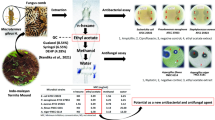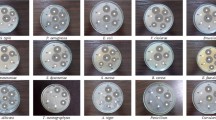Abstract
False yam (Icacina oliviformis) is a drought-resistant root crop found in Northern Ghana. Research confirms it to contain some levels of antimicrobial, antifungal, antidiarrheal, antioxidant, and antidiabetic activities. This study was carried out to determine the effectiveness of False yam extracts incorporated in liquid soap against selected microorganisms. Polar solvent (methanol, ethanol, and water) extracts from the leaves, tuber (root), peels (root bark), and seeds were diluted with liquid soap to give concentrations of 50 mg/mL, 25 mg/mL, and 12.5 mg/mL. Test organisms used were Staphylococcus aureus, Escherichia coli, and Vibrio species. The results revealed significant differences (P < 0.05) among the different solvents and concentrations of the plant materials used. The ethanol seed extract at a concentration of 50 mg/mL was most inhibitive on Vibrio species with an inhibition diameter of 13 mm. The methanol peel extract also had the greatest inhibition on Escherichia coli with average inhibition zone of 7 mm to 12.5 mm followed closely by the tuber with maximum inhibition zone of 9 mm. The leaf extract generally exhibited higher values of inhibition on Staphylococcus aureus with zone range of 10 mm to 15 mm. The highest activity occurred with an inhibition zone of 15 mm diameter. The tuber and peel extracts recorded the highest antibacterial activity. Staphylococcus aureus appeared to be the most susceptible organism and the methanol extracts exhibited a relatively high frequency of inhibition. Further research efforts should combine the tuber and peel extracts to determine the possible synergistic and/or antagonistic effect.



Similar content being viewed by others
References
Abtahi H, Ghazavi A, Karimi M, Mollaghasemi S, Mosayebi G (2008) Antimicrobial activities of water and methanol extracts of Bitter Apricot seeds. J Med Sci 8:433–436
Akuodor GC, Udia PM, Bassey A, Chilaka KC, Okezie OA (2014) Antihyperglycemic and antihyperlipidemic properties of aqueous root extract of Icacina senegalensis in alloxan induced diabetic rats. J Acute Dis 3(2):99–103. https://doi.org/10.1016/S2221-6189(14)60025-1
Ansah T (2014) Nutrient composition and in vitro gas production of false yam. Glob J Anim Sci Res 2(2):76–82
Ansah T, Aboagye C (2011) False yam (Icacina oliviformis) leaf meal as an ingredient in the diet of weaner rabbits (Oryctolagus cuncilus) to improve blood profile. Online J Anim Feed Res 1(4):135–138
Aqil F, Ahmad I (2003) Broad-spectrum antibacterial and antifungal properties of certain traditionally used Indian medicinal plants. World J Microbiol Biotechnol. https://doi.org/10.1023/A:1025128104056
Asuzu IU, Sosa S, Loggia DR (2015) The anti-inflammatory activity of Icacina trichantha tuber. Phytomedicine 6(4):267–272. https://doi.org/10.1016/S0944-7113(99)80019-1
Athar M, Nasir SM (2005) Taxonomic perspective of plant species yielding vegetable oils used in cosmetics and skin care products. Afr J Biotechnol 4(1):36–44
Beuchat LR (1995) Pathogenic microorganisms associated with fresh produce. J Food Prot 59(2):204–216
Chalew ET, Halden RU (2009) Environmental exposure of aquatic and terrestrial biota to triclosan and triclocarbon. J Am Water Resour Assoc 45(1):4–13
Cheeke PR (2001) Actual and potential application of Yucca schidigera and Quillaja saponaria saponins in human and animal nutrition. Proc Am Soc Anim Sci
David-Oku E, Bassey SC, Obiajunwa-Otteh JI, Ekpenyong EU (2017) Comparative phytochemical and antimicrobial activities of polar solvents tuber extracts of Icacina senegalensis A. Juss (Icacinaceae). Med Res Arch 5(11):1–9
Echo IA, Osuagwu AN, Agbor RB, Okpako EC, Ekanem BE (2012) Phytochemical composition of Aframomum melegueta and Piper guineense seeds. World J Appl Environ Chem 2(1):17–21
Edeoga HO, Okwu DE, Mbaebie BO (2005) Phytochemical constituents of some Nigerian medicinal plants. Afr J Biotechnol 4(7):685–688
Edoga MO (2009) Comparison of various fatty acid sources for making soft soap (Part 1): qualitative analysis. J Eng Appl Sci 4(2):110–113
Field JA, Lettinga G (1992) Toxicity of tannic compounds to microorganisms. In: Hemingway RW, Laks PE (eds) Plant polyphenols. Springer, Boston, MA, pp 673–674
Glaser A (2004) The ubiquitous triclosan-A common antibacterial agent exposed. Pesticides You 24(3):12–17
Guil-Guerrero JL, Ramos L, Moreno C, Zúñiga-Paredes JC, Carlosama-Yepez M, Ruales P (2016) Antimicrobial activity of plant-food by-products: a review focusing on the tropics. Livest Sci 189:32–49. https://doi.org/10.1016/j.livsci.2016.04.021
Hasan NA, Grim CJ, Lipp EK, Rivera ING, Chun J, Haley BJ, Taviani E (2015) Deep-sea hydrothermal vent bacteria related to human pathogenic Vibrio species. https://doi.org/10.1073/pnas.1503928112
Kareru PG, Keriko JM, Kenji GM, Thiong’o GT, Gachanja AN, Mukiira HN (2010) Antimicrobial activities of skincare preparations from plant extracts. Afr J Traditional CAM 7(3):214–218
Karsha PV, Lakshmi B (2010) Antibacterial activity of black pepper (Piper nigrum Linn.) with special reference to its mode of action on bacteria. Indian J Nat Prod Resour 1(2):213–215
Lehutso RF, Daso AP, Okonkwo JO (2017) Occurrence and environmental levels of triclosan and triclocarban in selected wastewater treatment plants in Gauteng Province, South Africa. Emerg Contam 3(3):107–114. https://doi.org/10.1016/j.emcon.2017.07.001
Loden M (2003) Role of topical emollients and moisturizers in the treatment of dry skin barrier disorders. Am J Clin Dermato. https://doi.org/10.2165/00128071-200304110-00005
Miranda JM, Franco CM, Vazquez BI, Fente CA, Barros-Velazquez J, Cepeda A (2005) Evaluation of Chromocult enterococci agar for the isolation and selective enumeration of Enterococcus spp. in broilers. Lett Appl Microbiol 41(2):153–156
Nascimento GGF, Locatelli J, Freitas PC, Silva GL (2000) Antibacterial activity of plant extracts and phytochemicals on antibiotic-resistant bacteria. Braz J Microbiol 31:247–256
Obiajunwa-Otteh IJ, Akuodor GC, Onyekpe P, Umoh EU (2014) Phytochemical and antimicrobial potency of the aqueous and methanol leaf extracts of Icacina senegalensis. Pharmacologia 5(8):321–325
Pfeffer C, Oliver JD (2003) A comparison of thiosulphate-citrate-bile-salts-sucrose (TCBS) agar and thiosulphate-chloride-iodide (TCI) ager for the isolation of Vibrio species from estuarine environments. Lett Appl Microbiol 36(3):150–151
Premanath R, Sudisha J, Devi NL, Aradhya SM (2011) Antibacterial and anti-oxidant activities of fenugreek (Trigonella foenumgraecum L.) leaves. Res J Med Plants 5(6):695–705. https://doi.org/10.3923/rjmp.2011.695.705
Rathee D, Rathee P, Rathee S, Rathee D (2012) Phytochemical screening and antimicrobial activity of Picrorrhiza kurroa, an Indian traditional plant used to treat chronic diarrhea. Arab J Chem 9:S1307–S1313. https://doi.org/10.1016/j.arabjc.2012.02.009
Sher A (2009) Antimicrobial activity of natural products from medicinal plants. Gomal J Med Sci 7(1):72–78
Sherburne JJ, Anaya AM, Fernie KJ, Forbey JS, Furlong ET, Kolpin DW, Dufty AM, Kinney CA (2016) Occurrence of triclocarban and triclosan in an agro-ecosystem following application of biosolids. Environ Sci Technol. https://doi.org/10.1021/acs.est.6b01834
Sorensen JPR, Lapworth DJ, Nkhuwa DCW, Stuart ME, Gooddy DC, Bell RA, Chirwa M, Kabika J, Liemisa M, Chibesa M, Pedley S (2014) Emerging contaminats in urban groundwater sources in Africa. Water Res 72:51–63
Stromberg J (2014) Five reasons why you should probably stop using antibacterial soap. Smithsonian Magazine
Strominger JL, Park JT, Thompson RE (1959) Composition of the cell wall of Staphylococcus aureus: its relation to the mechanism of action of penicillin. J Biol Chem 234(12):3263–3268
Suller MTE, Russell AD (2000) Triclosan and antibiotic resistance in Staphylococcus aureus. J Antimicrob Chemother 46:11–18
Timothy O, Idu M (2011) Preliminary phytochemistry and in vitro antimicrobial properties of aqueous and methanol extracts of Icacina trichantha Oliv. leaf. Int J Med Arom Plants 1(3):184–188
Umoh EO (2013) Antinutritional factors of false yam (Icacina trichantha) flour. Internet J Food Saf 15:78–82
Yadav M, Chatterji S, Gupta SK, Watal G (2014) Preliminary phytochemical screening of six medicinal plants used in traditional medicine. Int J Pharm Sci 6(5):539–542
Acknowledgments
We are most grateful to Mr. Ofosu Asanti Aning and Mr. Yelkuro Mwintuana of CSIR-Savannah Agricultural Institute for assisting with the laboratory analysis.
Author information
Authors and Affiliations
Corresponding author
Ethics declarations
Conflict of interest
The authors declare that they have no conflict of interest.
Additional information
Editorial responsibility: M. Abbaspour.
Rights and permissions
About this article
Cite this article
Amadu Baba, N., Quainoo, A.K., Cobbina, S.J. et al. Inhibition of bacterial growth using false yam (Icacina oliviformis) extract as an additive in liquid soap. Int. J. Environ. Sci. Technol. 16, 7049–7058 (2019). https://doi.org/10.1007/s13762-019-02382-8
Received:
Revised:
Accepted:
Published:
Issue Date:
DOI: https://doi.org/10.1007/s13762-019-02382-8




